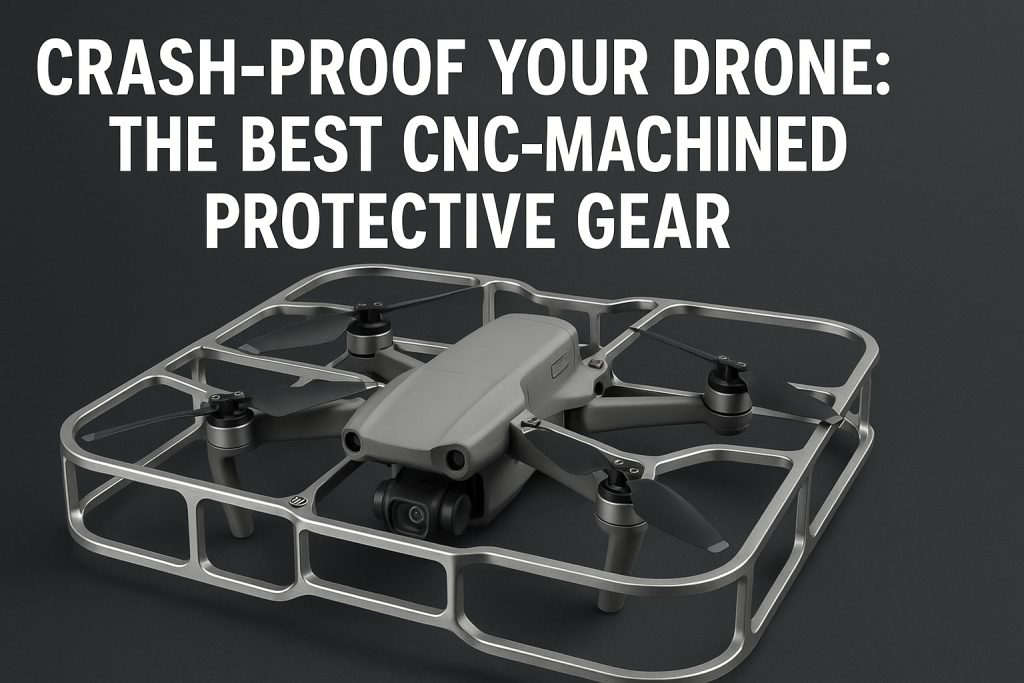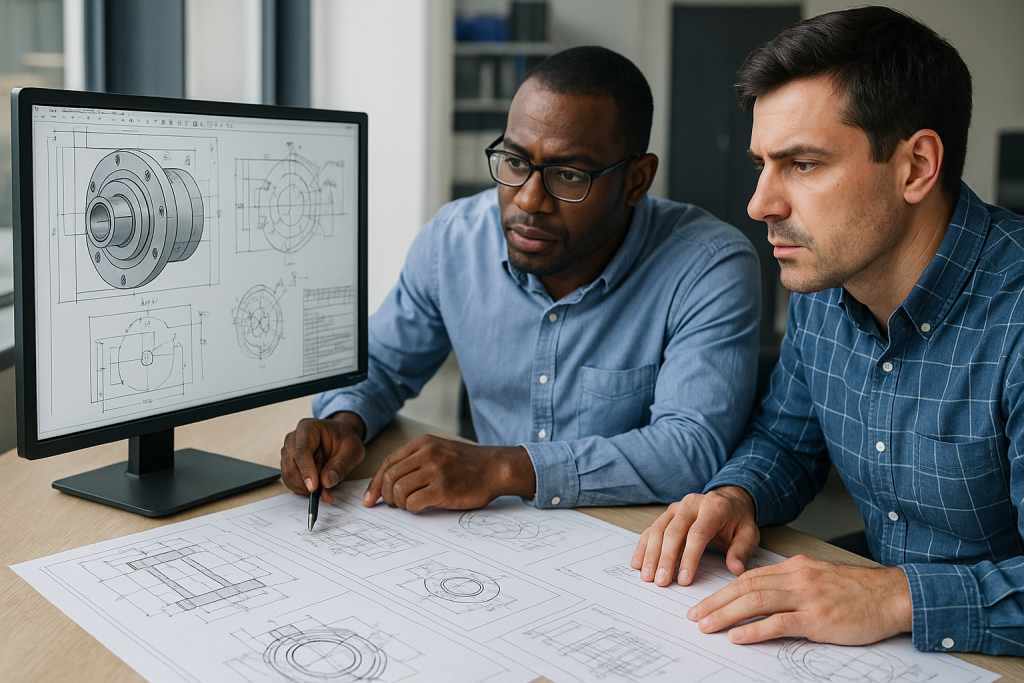
Drone crashes are inevitable—even for experienced pilots. Whether you’re navigating tight indoor spaces, battling high winds, or pushing your UAV to its performance limits, protection matters. The key to minimizing damage lies in robust structural components, and that’s where CNC-machined protective gear comes into play.
I. Why CNC Machining Is Essential for Drone Durability
Traditional plastic moldings or 3D printed parts can’t match the strength and precision of CNC-milled components. CNC (Computer Numerical Control) machining allows manufacturers to create aerospace-grade parts with micron-level accuracy and repeatability.
According to Boona Prototypes, CNC machining enables tight tolerances and superior material integrity—making it ideal for mission-critical drone applications.
II. Top CNC-Machined Components for Crash Resistance
| Component | Function | Recommended Material | Machining Notes |
|---|---|---|---|
| Motor Mounts | Keep motors aligned; prevent vibration | 6061/7075 Aluminum | ±0.01mm tolerance; anodized finish |
| Propeller Hubs | Secure props; reduce rotor imbalance | Stainless Steel or Brass | Balanced on 5-axis mill |
| Landing Gear Skids | Absorb shock during landing/crash | Titanium or Nylon | Hollow core with flexible feet |
| Surround Frame/Guards | Shield propellers from impacts | Carbon Fiber or ABS | Precision-cut CNC for weight reduction |
| Center Plates | Structural spine; distributes force evenly | Carbon Composite/Aluminum | Dual-layer with shock-absorbing inserts |
III. Choosing the Right Material for Your Drone’s Frame
Material Comparison for CNC Drone Parts
| Material | Weight | Tensile Strength | Corrosion Resistance | Machinability |
|---|---|---|---|---|
| 7075 Aluminum | ★★★★☆ | 74,000 psi | ★★★☆☆ | ★★★★☆ |
| Titanium Grade 5 | ★★★☆☆ | 130,000 psi | ★★★★★ | ★★★☆☆ |
| Carbon Fiber | ★★★★★ | ~70,000 psi (layered) | ★★★★☆ | ★★★★☆ (CNC cut) |
| ABS Plastic | ★★★★☆ | 4,000 psi | ★★★☆☆ | ★★★★★ |
| Nylon Composite | ★★★★☆ | 7,000–12,000 psi | ★★★★☆ | ★★★★☆ |
IV. Surface Treatments for Impact and Weather Resistance
-
Anodizing – Hardens aluminum surfaces and prevents corrosion
-
Powder coating – Offers wear resistance and aesthetic appeal
-
Passivation – Improves stainless steel’s corrosion resistance
-
UV-resistant polymers – Maintain plastic strength in outdoor conditions
Boona Prototypes provides one-stop CNC machining and surface finishing services, streamlining the production of custom protective drone parts. Learn more at their CNC services page.
V. Prototyping Crash Zones for Safe Failure
Advanced CNC drone frames now feature modular crash zones—areas designed to absorb damage and be easily replaced:
-
Arm sacrificial joints that break off to preserve the central hub
-
Removable landing legs mounted with rubber dampers
-
Prop guards with flexible mounting points for energy dissipation
Through CNC prototyping, you can iterate quickly on these designs. Boona’s engineering team can assist with both prototyping and low-volume production to validate crash performance before mass production.
VI. Custom Shock Absorption Inserts
In addition to structural protection, many drone designers integrate CNC-cut EVA foam or rubber inserts into their carrying cases or motor mounts to reduce shock transfer. These materials can be laser-scanned and milled precisely using Boona’s advanced equipment.
Conclusion: Fly Smarter with CNC-Grade Protection
CNC-machined drone protection gear offers a high-performance shield against the most common crash-related damages. With tight tolerances, premium materials, and modular design, you can upgrade your drone for both hobby and commercial missions.
If you’re ready to protect your drone with custom CNC parts, visit Boona Prototypes to explore their full capabilities—from prototyping to production.
FAQs
1. What are the benefits of using CNC-machined parts for drones?
CNC-machined parts offer exceptional precision, material strength, and repeatability. They outperform 3D printed or injection-molded parts in durability, making them ideal for critical structural drone components like motor mounts, prop hubs, and landing gear.
2. Are CNC-machined drone parts lightweight enough for flight?
Yes. Materials like 7075 aluminum and carbon fiber are both strong and lightweight, making them perfect for drones. CNC machining allows for detailed internal cavities and weight-optimized geometries without compromising performance.
3. Which drone components are most important to reinforce with CNC parts?
The most crash-sensitive parts include:
-
Motor mounts and arms
-
Landing gear/skids
-
Center plate or chassis
-
Propeller guards
-
Gimbal mounts (if applicable)
Reinforcing these with CNC-machined components can significantly reduce damage during crashes.
4. Can CNC parts be customized for my specific drone model?
Absolutely. Companies like Boona Prototypes offer custom CNC machining based on CAD drawings or physical samples. You can tailor dimensions, materials, and finish for exact compatibility.
5. How do I choose the right material for crash-resistant drone parts?
It depends on your drone’s use case:
-
Aluminum 6061/7075: Lightweight and strong for frames
-
Titanium: Extremely durable, ideal for high-stress parts
-
Carbon fiber: Lightweight and stiff, perfect for arms and guards
-
ABS/Nylon: Good for flexible crash guards and brackets
Check Boona CNC material guide for more technical specs.
6. What surface treatments should I consider for CNC drone parts?
Protective finishes like anodizing (for aluminum), passivation (for stainless steel), or powder coating (for general wear resistance) help improve corrosion resistance and extend the life of your drone parts.
7. Are crash zones or breakaway parts CNC-machinable?
Yes. You can design sacrificial arms or modular frames with intentional stress points that absorb energy during a crash. CNC machining ensures consistent quality for these precision failure zones.
8. How can I test whether my CNC drone upgrades are crash-proof?
Start with simulations and controlled impact tests. You can also prototype crash zones using CNC low-volume production, a service offered by Boona Prototypes.
9. Is CNC gear only for professional or industrial drones?
Not at all. Many hobbyists and custom drone builders use CNC parts for FPV, racing, and photography drones. CNC upgrades increase reliability and reduce repair costs over time.
10. How do I get a quote or design support for custom CNC drone parts?
You can contact Boona Prototypes with your CAD files or design sketches. They provide engineering feedback, cost estimates, and manufacturing guidance.



